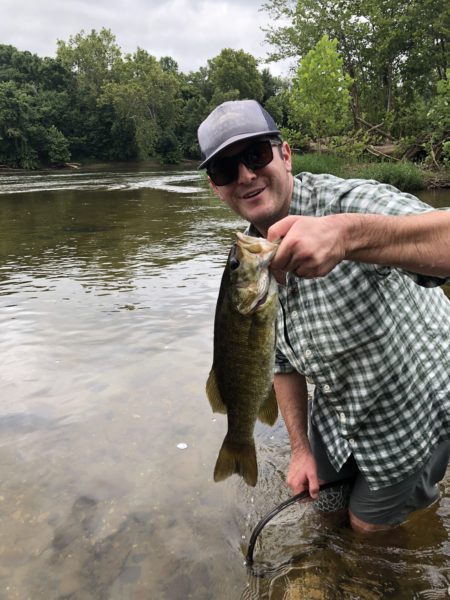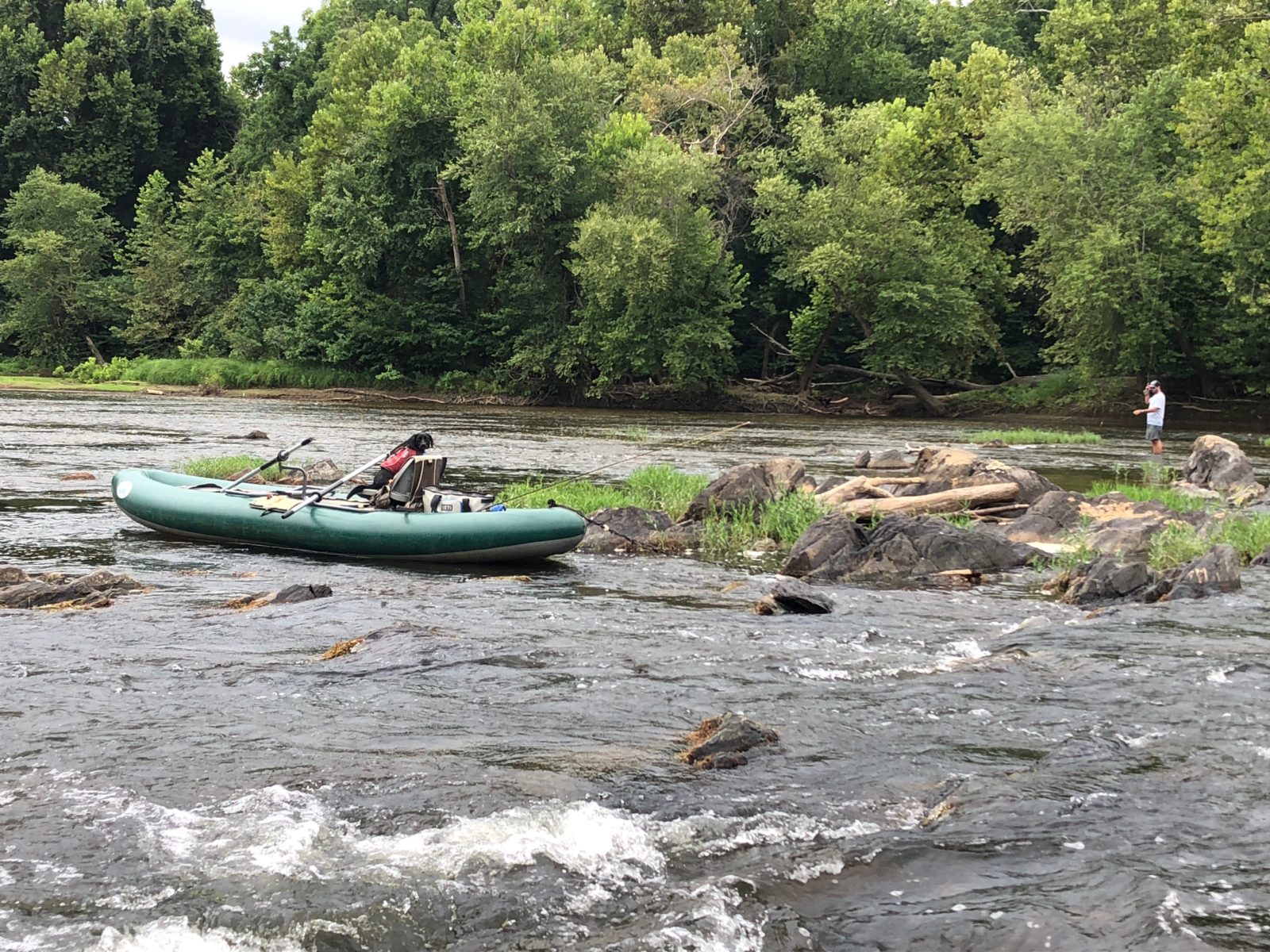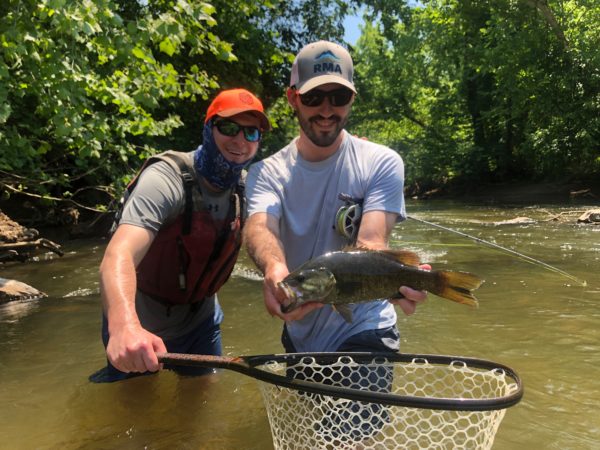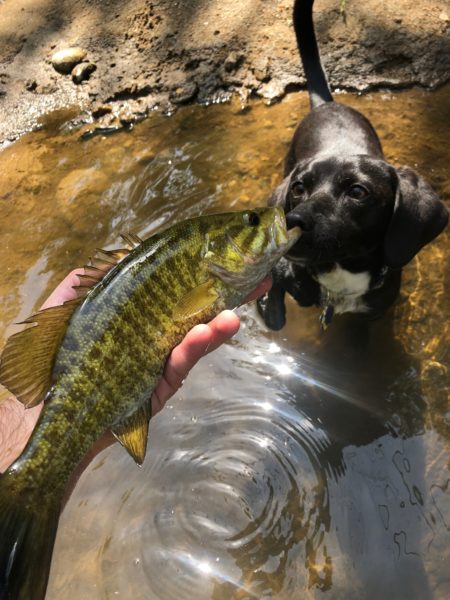
By Alex McCrickard, Virgina DGIF Aquatic Education Coordinator
from The Fishing Wire
During the dog days of summer, many anglers put their rods and reels down and are content to wait until later in the fall for cooler weather. Unfortunately, these anglers end up missing some of the most exciting warm water fishing conditions of the year. During this time frame, I tend to focus my efforts on one species of fish in Virginia, smallmouth bass. Pound for pound and inch for inch, these fish fight harder than most other freshwater fish in the state.
Smallmouth Bass in Virginia
Smallmouth bass, frequently referred to as smallies or bronzebacks, are a freshwater member of the sunfish family: Centrarchidae. Their green and brown sides are often marked with vertical black bars. Some of these fish have war paint like markings extending horizontally and diagonally behind their eyes and across their gill plates. Smallmouth bass are native to the Great Lakes system and the Mississippi River Basin including the Tennessee and Big Sandy River Drainages of Southwest Virginia. However, these game fish have been introduced all across the Piedmont of Virginia and are truly a worthy opponent on rod and reel. Because of the smallmouth’s widespread range in Virginia, they are readily available to anglers fishing west of the coastal plains above the fall lines of our major river systems. This allows anglers who reside in cities and large metropolitan areas to fish local as smallmouth opportunities are plentiful. The James River in Lynchburg and Richmond, Rappahannock River in Fredericksburg, Rivanna River in Charlottesville, Maury River near Lexington, and the New River in Blacksburg are fine examples of local opportunities.
The author with a fine summer smallmouth on the James River. Photo by Joe Revercomb.
The mainstem and larger tributaries of these rivers are full of smallmouth. Anglers in Northern Virginia can focus efforts on the Upper Potomac River as well as the Shenandoah mainstem, North Fork, and South Fork. The North Fork of the Holston River and the Clinch River provide excellent smallmouth opportunities in Southwest Virginia. Floating these larger rivers in a canoe or raft can be a great way to cover water, just remember to wear your life jacket. You can also wade fish these rivers and their tributaries, especially in the lower flows of late summer.
Summer Conditions
My favorite conditions to fish for smallmouth are from mid-summer into early fall. During this time of the year our rivers and streams are typically at lower flows with fantastic water clarity. These conditions provide for some incredible sight fishing opportunities for smallmouth bass. Look for fish to be holding against steep banks with overhanging trees and vegetation. During the middle of hot summer days it can pay off huge when you find a shady bank with depth and current. It can also be productive to target riffles and pocket water during this time of the year. Smallmouth will often be in the faster and more oxygenated water when river temperatures get hot.
It’s important to think about structure when locating summer smallmouth. These fish will often be found along a rock ledge or drop off. Log jams, underwater grass beds, and emergent water willow also provide structure that these fish can use for cover. Smallmouth can be found along current seams where fast water meets slow water. Fishing a quiet pocket behind a mid-river boulder or targeting the tailout of an island where two current seams come together is a good idea.
During hot, bright, summer days the fishing can be most productive early in the morning and again in the evening. I try to fish during these times as smallmouth will often be active during low light conditions and can get sluggish during the middle of a hot bright afternoon. That being said, these fish can be caught in the middle of bright sunny days as well. Also, afternoon cloud cover and a light shower can turn the fishing on in a matter of moments.
Wade fishing can be a great way to break up a float during a hot summer day. Photo by Alex McCrickard
Summer Feeding Habits
Smallmouth bass are piscivores, they feed primarily on other fish. Various species of shiners, darters, dace, and sunfish are bass favorites. These fish also prefer large aquatic insects like hellgrammite nymphs and crayfish. However, the abundance of other aquatic and terrestrial insects allow smallmouth to diversify their menu in the summertime. It is not uncommon for these fish to target damselflies and dragonflies during summer hatches. I’ve seen summer smallmouth feeding on the surface with reckless abandon as damselflies hovered along a water willow island on the James River. These fish are happy to eat large cicadas, grasshoppers, or crickets that find their way into the water. These seasonal food sources allow for exciting topwater action.
One time during a mid-August float on the James River I found a long bank with overhanging sycamore trees providing shade along the edge of the river. I had been fishing a subsurface Clouser Minnow without a strike for nearly an hour. Because it was a windy afternoon I figured I would try my luck with a small green Boogle Bug popper on my 6 wt fly rod. A few casts later I had a fine smallmouth explode on the popper underneath the overhanging tree limbs. I landed the fish and held it up for a photo just in time to see it regurgitate a half dozen large Japanese beetles. The fish had been utilizing the windy conditions to snack on beetles as they got blown into the water. It can really pay off to change patterns based on water and weather conditions.
Fishing with friends is a great way to spend time on the water. Joe Revercomb shows off a nice Virginia smallmouth caught on a popper. Photo by Patrick Dudley
Rods/Reels & Tackle/Approach
Medium to medium light spinning and baitcasting rods in the 7 foot range are great for late summer smallmouth. It can pay off to scale down in low clear water. You may want to consider fishing 6-8 lb test instead of 10-12 lb. Soft plastics work well for smallmouth and favorites include swim baits and tubes. Various spinnerbaits can be a great way to cover water in the larger rivers during this time of the year. Sometimes you can be surprised at how well a simple Mepps spinner or Rooster tail will produce. Topwater baits are a late summer “go to” with low and clear water. Try fishing buzzbaits, the smaller Whopper Plopper 90, Zara Spooks, and Heddon Tiny Torpedos. Buzzbaits and Whopper Ploppers can be retrieved quickly across the surface enticing explosive takes. The rotating tail of the Whopper Plopper acts like a propeller and creates lots of noise and attention.
For fly fishing, 9 to 10 foot rods in the 6 to 8 wt range are best. A 9ft 5wt may work well on the smaller rivers across Virginia but you will want a heavier rod on our larger rivers. Heavier rods in the 7 to 8 wt range will also turn over some of the bigger bugs we tend to throw this time of year on floating fly lines. A 9ft tapered leader in the 0x to 3x range will work well depending on water clarity and flows. Fishing large poppers like Boogle Bugs or Walt Cary’s “Walt’s Bass Popper” will get the smallmouth going. The Surface Seducer Double Barrel popper by Martin Bawden pushes lots of water. Large foam cicada patterns, Japanese beetle patterns, and western style Chernoyble Ants are fun when fished tight to the bank. Don’t forget to include a few damselfly and dragonfly patterns in your summer smallmouth fly box.
Don’t let the dog days of summer keep you from missing some of the most exciting warm water fishing conditions of the year!
When fishing these surface flies and lures, the takes can be very visual. Sometimes during a strip and pause retrieve, the smallmouth will slowly approach the fly from 5 feet away to gently sip it like a trout. Other times a fast strip retrieve will generate explosive takes. These visual late summer takes are hard to beat!
If the fish aren’t looking up you can do well stripping streamers. Bob Clouser’s Clouser Minnow was developed for smallmouth bass and a variety of colors can be productive this time of the year. My favorite color combinations for this fly are chartreuse and white, olive and white, as well as a more natural brown and white. The dumbbell eyes on this fly make it swim up and down through the water column as you retrieve. Lefty Kreh’s Deceiver is another fine smallmouth fly along with the famous Half & Half which is a combination of the Clouser Minnow and Deceiver. Chuck Kraft’s Kreelex has become a favorite amongst fly anglers in Virginia and the smallmouth can’t seem to ignore it. The flashy profile of this fly attracts fish in clear and stained water. Another popular smallmouth streamer is the Gamechanger developed by Blane Chocklett. The Gamechanger is multi-sectioned allowing it to swim naturally through the water column. Most other articulated streamers developed for trout fishing will also be productive on smallmouth bass as well. All of these streamers come in a variety of sizes. When choosing fly size, it’s essential to match the size of the forage fish the smallmouth are keying in on. This can vary from larger rivers to smaller tributaries but typically sizes 2-6 will work well with larger patterns being in the 1, 1/0, and 2/0 sizes.
Crayfish and Hellgrammite patterns can be productive during the heat of the day in late summer. Harry Murray’s Hellgrammite and Strymph can be fished with success lower in the water column closer to the bottom of the river. Chuck Kraft’s Clawdad and Crittermite are two other go to patterns. Its best to try numerous different approaches and techniques until you can find out what the fish are keyed in on each day.
In all, late summer smallmouth should be on your angling to do list. The conditions during this time of the year are excellent for sight fishing and cater to a topwater approach. From the smaller tributaries to the larger rivers, smallmouth opportunities are diverse across the state. Make time to get out this summer and fish local in Virginia.